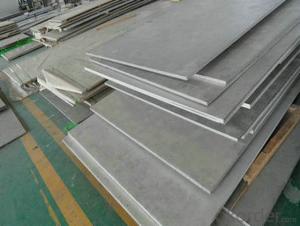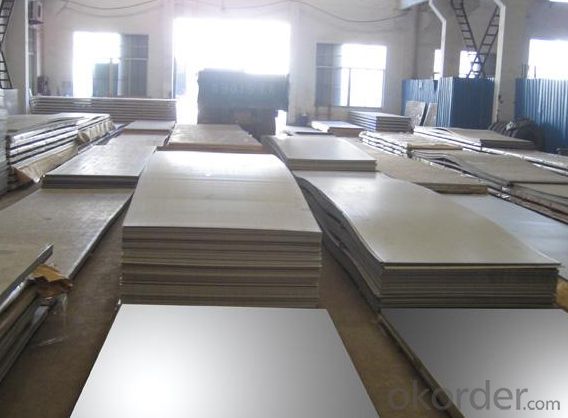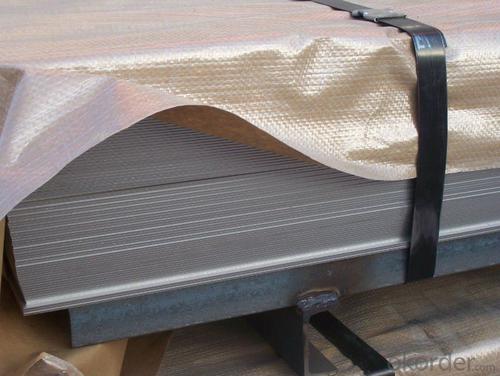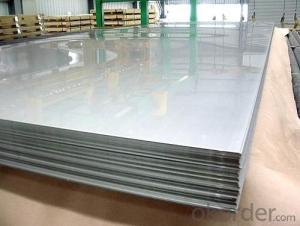Stainless Steel sheet and plate with Innovative Tech
- Loading Port:
- Shanghai
- Payment Terms:
- TT OR LC
- Min Order Qty:
- 10000 m.t.
- Supply Capability:
- 5000000 m.t./month
OKorder Service Pledge
OKorder Financial Service
You Might Also Like
Specifications of stainless steel
304 stainless Steel Plate
stainless steel plate,steel sheet,steel plate
Standard: ASTM,GB,DIN,JIS,ISO,EN,etc.
TISCO stainless Steel Plate 304/NO.1 finished
stainless steel plate,steel sheet,steel plate
Standard: ASTM,GB,DIN,JIS,ISO,EN,etc.
Delivery short and low cost advantage.
Description of stainless steel:
stainless steel plate,hot rolled stainless steel plate,cold rolled stainless steel plate,stainless steel sheet,steel sheet,sheet


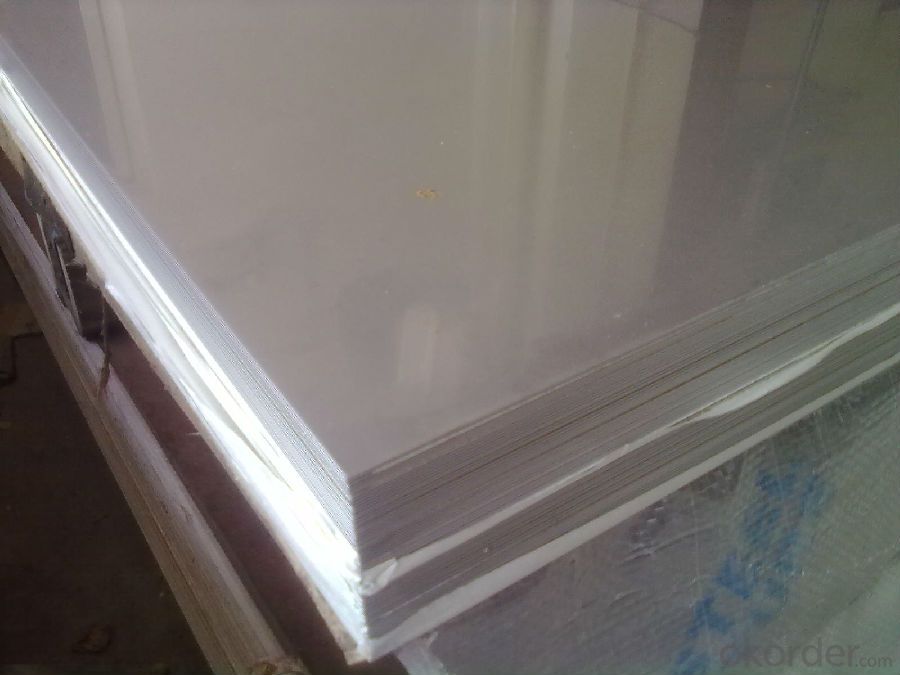



Material of stainless steel:
304,304L,309S,310S,316,316L,316Ti,317L,317L,321,347H,409,409L,410S,420,430,201,202,etc.
Thickness of stainless steel:
From 0.3mm to 100mm
Width of stainless steel:
1000mm,1219mm,1250mm,1500mm,1800mm,2200mm,2500mm or as your requirement
Length of stainless steel:
2000mm,2438mm,2500mm,6000mm,6096mm or as your requirement
Application of stainless steel:
Stainless steel plate applies to construction field, ships building industry, petroleum & chemical industries, war and electricity industries, food processing and medical industry, boiler heat exchanger, machinery and hardware fields. Our company has cooperative relation between the domestic agents. Stainless steel plate can be made accordingto the customers requirements. Fasten delivery. Quality assured.Welcome to order more.
Contacts
If you have any question,please feel free to contact us.
- Q: How do you prevent warping or distortion in stainless steel sheets?
- To prevent warping or distortion in stainless steel sheets, several measures can be taken. First, it is important to properly handle and store the sheets to prevent any bending or twisting during transportation or storage. Secondly, ensuring a smooth and even distribution of heat during welding or fabrication processes can help minimize the chances of warping. Additionally, using proper clamping techniques and supports during machining or cutting operations can help maintain the shape and integrity of the stainless steel sheets. Lastly, adhering to the recommended thicknesses and specifications provided by the manufacturer for specific applications can also help prevent warping or distortion in stainless steel sheets.
- Q: What are the different types of stainless steel sheet surface coatings for outdoor applications?
- There are several different types of stainless steel sheet surface coatings that are commonly used for outdoor applications. These coatings are designed to enhance the durability and corrosion resistance of the stainless steel, making it suitable for use in harsh outdoor environments. One of the most common coatings used for outdoor applications is a powder coating. Powder coating is a process in which a dry powder is applied to the stainless steel surface and then cured under heat to form a protective layer. This coating provides excellent resistance to corrosion, UV rays, and chemicals, making it ideal for outdoor use. It also offers a wide range of color options, allowing for customization and aesthetic appeal. Another type of coating commonly used for outdoor applications is a PVD (Physical Vapor Deposition) coating. This process involves the deposition of a thin film of material onto the stainless steel surface through a vacuum chamber. PVD coatings provide excellent adhesion, wear resistance, and corrosion resistance, making them suitable for outdoor applications. They also offer a variety of decorative finishes, such as gold, bronze, or black, which can enhance the appearance of the stainless steel. Additionally, stainless steel can be coated with a ceramic coating for outdoor use. Ceramic coatings are typically applied through a high-temperature spray process, which forms a hard, protective layer on the stainless steel surface. These coatings offer superior resistance to abrasion, chemicals, and UV rays, making them ideal for outdoor applications that require high durability. In summary, the different types of stainless steel sheet surface coatings for outdoor applications include powder coating, PVD coatings, and ceramic coatings. Each of these coatings provides unique benefits in terms of corrosion resistance, durability, and aesthetic appeal, allowing for the use of stainless steel in a wide range of outdoor environments.
- Q: Can stainless steel sheets be used in medical applications?
- Certainly, medical applications can indeed utilize stainless steel sheets. The medical sector favors stainless steel for its remarkable resistance against corrosion, its durability, and its simplicity when it comes to sterilization. It finds extensive employment in medical devices, surgical instruments, and implantable components, as it can endure rigorous sterilization procedures like autoclaving. This capability is pivotal in upholding cleanliness and averting infections. Moreover, stainless steel is biocompatible, signifying that it does not interact negatively with bodily tissues or induce any harm or adverse responses. All in all, stainless steel sheets are an unwavering and adaptable material suitable for a plethora of medical applications.
- Q: Are stainless steel sheets resistant to scaling?
- Yes, stainless steel sheets are highly resistant to scaling. Due to their chromium content, they form a protective layer that prevents oxidation and scaling even at high temperatures.
- Q: Are stainless steel sheets resistant to lactic acid?
- Stainless steel sheets are commonly resistant to lactic acid. The corrosion resistance of stainless steel is well-known, and lactic acid is generally not potent enough to cause substantial harm to surfaces made of stainless steel. Nevertheless, the level of resistance may differ based on the specific grade and quality of stainless steel employed. To ensure the suitability of stainless steel sheets for applications involving lactic acid, it is advisable to seek guidance from a material expert or conduct appropriate testing.
- Q: What is the function of a stainless steel plate at the top of the steel chimney?
- According to some characteristic elements of main chemical components in steel or steel in the classification, divided into chromium stainless steel, chromium nickel stainless steel, nickel chromium molybdenum stainless steel and low carbon steel, stainless steel, stainless steel and high molybdenum high purity; according to the characteristics and application of classification of steel, stainless steel, divided into nitric acid resistant stainless steel, high resistance to sulfuric acid pitting resistance to stress corrosion of stainless steel, stainless steel, stainless steel and other steel; according to the classification features, divided into low temperature stainless steel, non-magnetic stainless steel, stainless steel, stainless steel, free cutting superplasticity.
- Q: Are stainless steel sheets suitable for brewing equipment?
- Yes, stainless steel sheets are highly suitable for brewing equipment due to their durable, corrosion-resistant, and hygienic properties. Stainless steel is able to withstand the harsh conditions of the brewing process, including high temperatures and acidic environments, while preventing contamination and maintaining the quality of the beer. Additionally, stainless steel is easy to clean and maintain, making it a preferred material for brewing equipment.
- Q: Can stainless steel sheets be used for fire escapes?
- Yes, stainless steel sheets can be used for fire escapes. Stainless steel is a highly durable and resistant material that can withstand high temperatures and maintain structural integrity during a fire. It is non-combustible and does not emit toxic gases when exposed to heat, making it a safe choice for fire escape construction. Additionally, stainless steel is corrosion-resistant, which ensures the longevity and reliability of the fire escape system. Overall, stainless steel sheets are an excellent choice for fire escapes due to their strength, fire resistance, and durability.
- Q: What is the maximum thickness of stainless steel sheets for bending?
- The maximum thickness of stainless steel sheets for bending can vary depending on the specific grade and type of stainless steel being used. In general, stainless steel sheets up to around 6mm thick can be easily bent, while thicker sheets may require specialized equipment and techniques for successful bending.
- Q: Are stainless steel sheets good for heat exchangers?
- Yes, stainless steel sheets are good for heat exchangers. Stainless steel is a popular choice for heat exchangers due to its excellent corrosion resistance, high temperature resistance, and strength. It can withstand extreme temperatures and pressures, making it ideal for various industrial applications. Additionally, stainless steel sheets offer good thermal conductivity, allowing for efficient heat transfer between fluids. Their durability and resistance to fouling and scaling also contribute to their suitability for heat exchangers, ensuring long-term performance and reliability.
Send your message to us
Stainless Steel sheet and plate with Innovative Tech
- Loading Port:
- Shanghai
- Payment Terms:
- TT OR LC
- Min Order Qty:
- 10000 m.t.
- Supply Capability:
- 5000000 m.t./month
OKorder Service Pledge
OKorder Financial Service
Similar products
Hot products
Hot Searches
Related keywords




